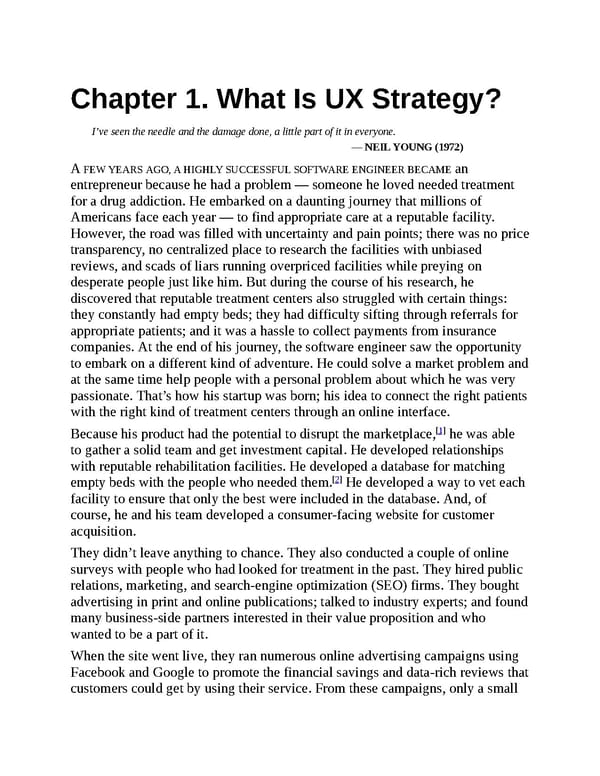Chapter 1. What Is UX Strategy? I’ve seen the needle and the damage done, a little part of it in everyone. — NEIL YOUNG (1972) A FEW YEARS AGO, A HIGHLY SUCCESSFUL SOFTWARE ENGINEER BECAME an entrepreneur because he had a problem — someone he loved needed treatment for a drug addiction. He embarked on a daunting journey that millions of Americans face each year — to find appropriate care at a reputable facility. However, the road was filled with uncertainty and pain points; there was no price transparency, no centralized place to research the facilities with unbiased reviews, and scads of liars running overpriced facilities while preying on desperate people just like him. But during the course of his research, he discovered that reputable treatment centers also struggled with certain things: they constantly had empty beds; they had difficulty sifting through referrals for appropriate patients; and it was a hassle to collect payments from insurance companies. At the end of his journey, the software engineer saw the opportunity to embark on a different kind of adventure. He could solve a market problem and at the same time help people with a personal problem about which he was very passionate. That’s how his startup was born; his idea to connect the right patients with the right kind of treatment centers through an online interface. [1] Because his product had the potential to disrupt the marketplace, he was able to gather a solid team and get investment capital. He developed relationships with reputable rehabilitation facilities. He developed a database for matching [2] empty beds with the people who needed them. He developed a way to vet each facility to ensure that only the best were included in the database. And, of course, he and his team developed a consumer-facing website for customer acquisition. They didn’t leave anything to chance. They also conducted a couple of online surveys with people who had looked for treatment in the past. They hired public relations, marketing, and search-engine optimization (SEO) firms. They bought advertising in print and online publications; talked to industry experts; and found many business-side partners interested in their value proposition and who wanted to be a part of it. When the site went live, they ran numerous online advertising campaigns using Facebook and Google to promote the financial savings and data-rich reviews that customers could get by using their service. From these campaigns, only a small
 UX Strategy: How to Devise Innovative Digital Products that People Want Page 13 Page 15
UX Strategy: How to Devise Innovative Digital Products that People Want Page 13 Page 15